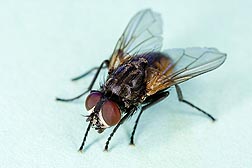This page has been archived and is being provided for reference purposes only. The page is no longer being updated, and therefore, links on the page may be invalid.
| Read the magazine story to find out more. |
|
|
Delivering a Virus that Gets Rid of House Flies
By Sandra AvantApril 8, 2013
U.S. Department of Agriculture (USDA) scientists have found an effective method to infect house flies with a virus that stops the flies from reproducing.
House flies can transmit hundreds of animal and human pathogens like Salmonella, Escherichia coli and Shigella bacteria, which cause foodborne illnesses. Insecticides are used to help control flies, but the pests can develop resistance to chemicals.
Entomologist Christopher J. Geden, with the Agricultural Research Service (ARS) Center for Medical, Agricultural and Veterinary Entomology in Gainesville, Fla., examined salivary gland hypertrophy virus (SGHV), a member of a newly discovered family of viruses called Hytrosaviridae. ARS is USDA's chief intramural scientific research agency.
Collaborating with scientists at the University of Florida and Denmark's Aarhus University, Geden looked at SGHV's distribution and host range, and the effectiveness of different application methods on house flies. The virus reproduces in the salivary gland of the infected insects, preventing the females from laying eggs and preventing the males from mating.
Scientists examined different approaches to increase the virus infection rate in flies. The best method was a crude mixture of Danish SGHV-infected flies and water. A strain of healthy flies that had been dipped directly into the mixture or that walked on treated surfaces had an infection rate of 56 percent. A Florida strain had a 50 percent infection rate.
Liquid baits containing SGHV produced an infection rate of 22 percent (Danish virus) or 26 percent (Florida virus) in flies. When flies were sprayed directly with SGHV, the Danish virus infected 18 percent and the Florida virus infected 22 percent.
In other laboratory tests, Florida house flies were highly susceptible when injected with SGHV. Black dump flies were severely affected, and stable flies died quickly or failed to develop ovaries after injection.
While the virus shows great potential in controlling house and other filth flies, it is not a quick fix, according to Geden. However, SGHV could become part of an integrated management program that involves treating natural fly populations early during peak season to reduce reproduction.
Read more about this research in the April 2013 issue of Agricultural Research magazine.

